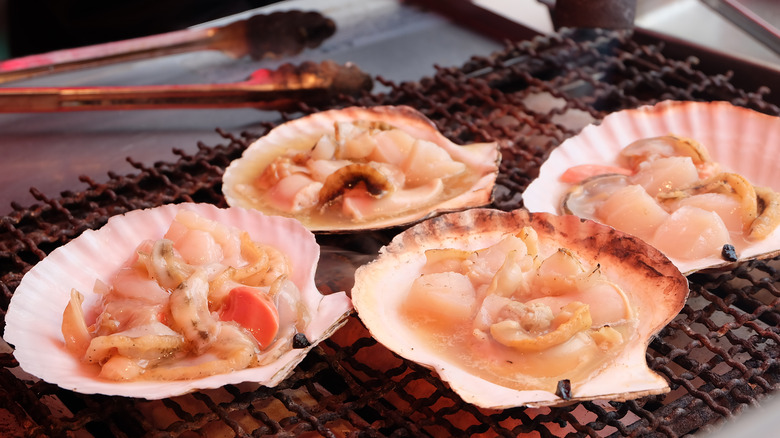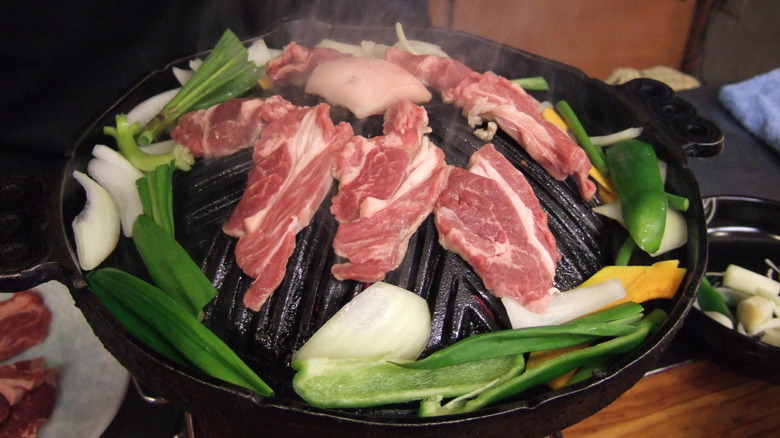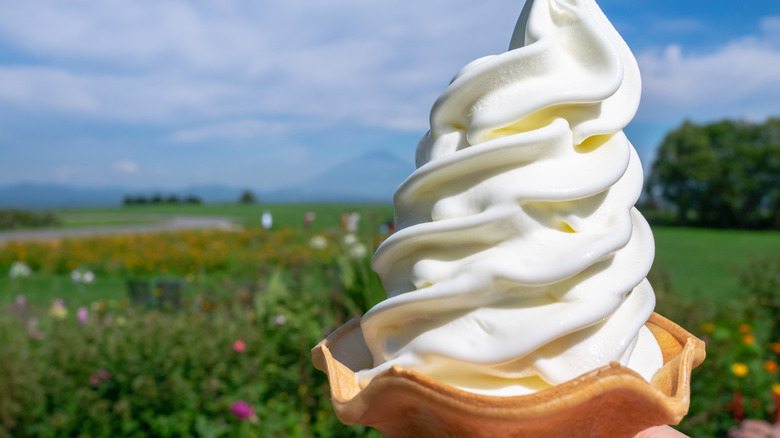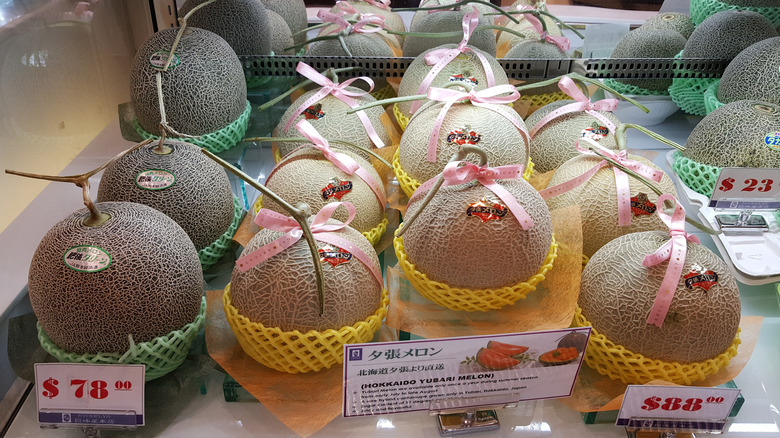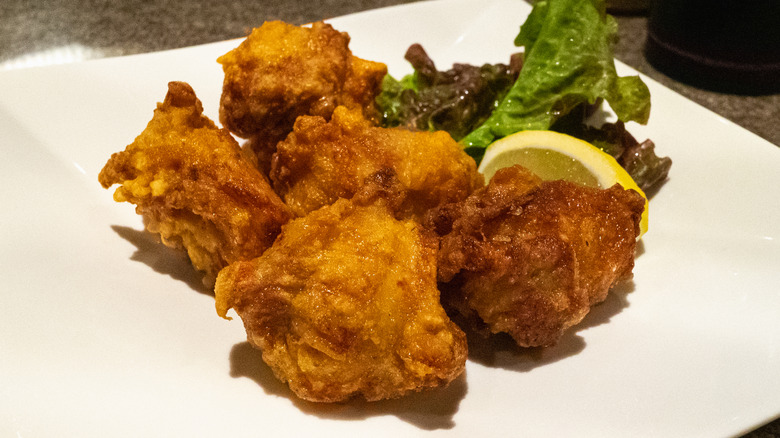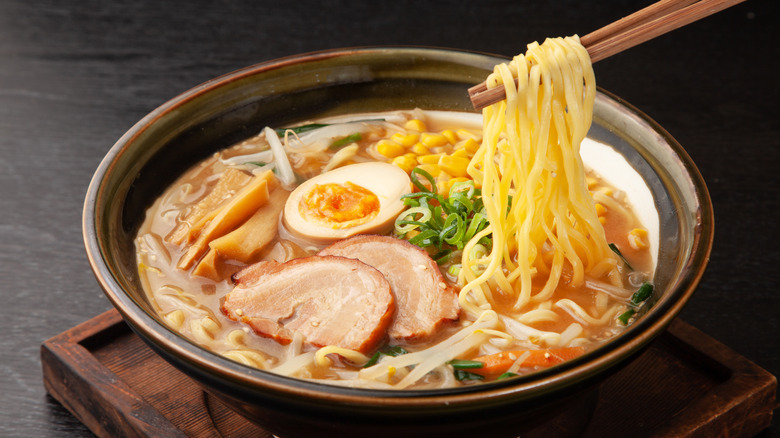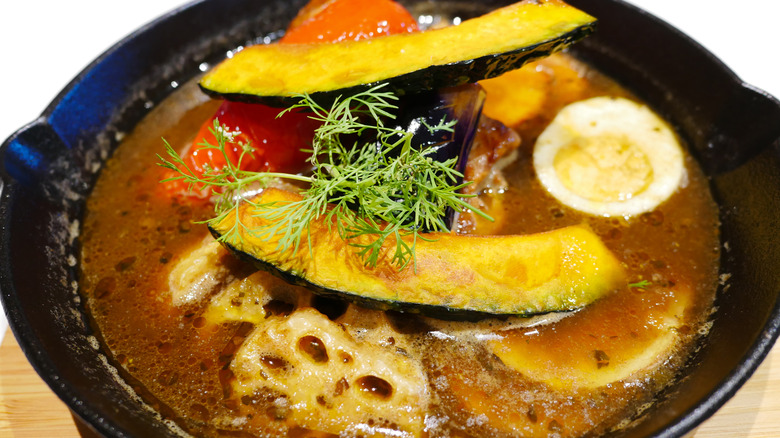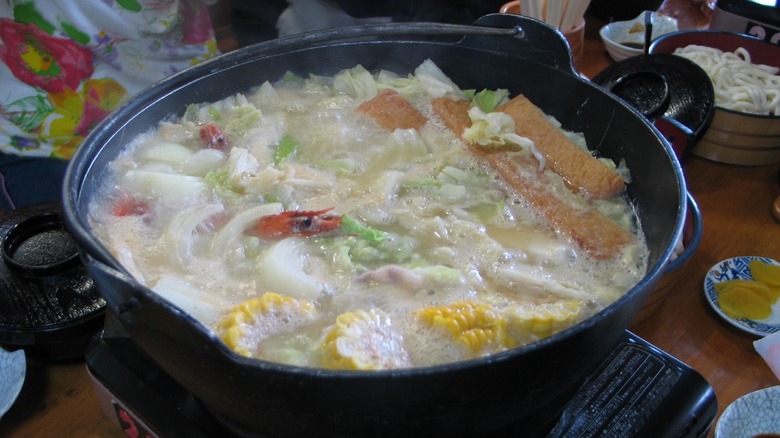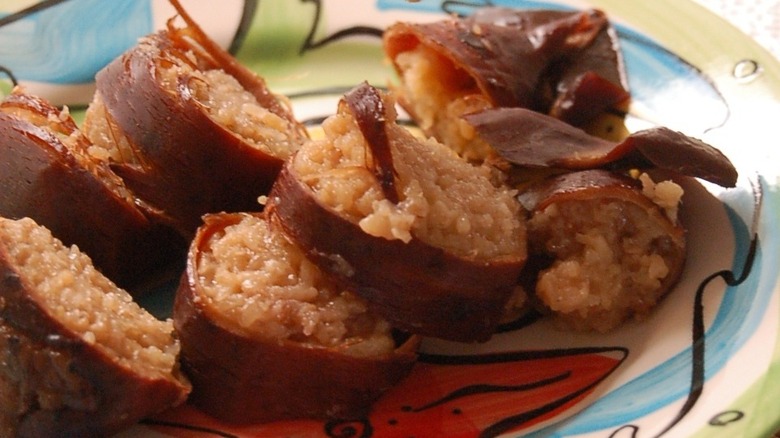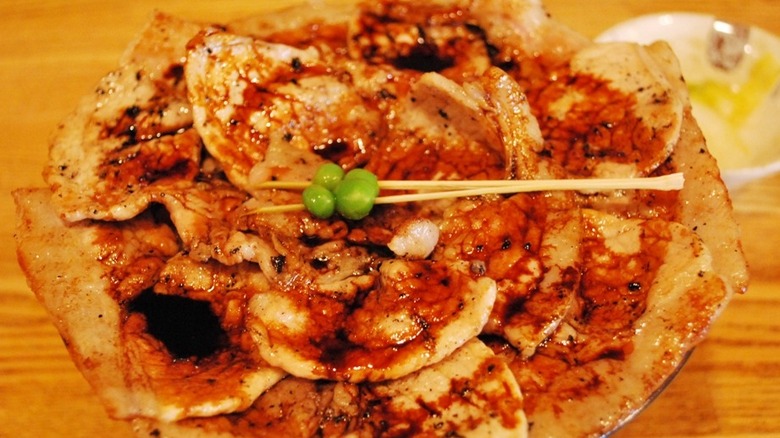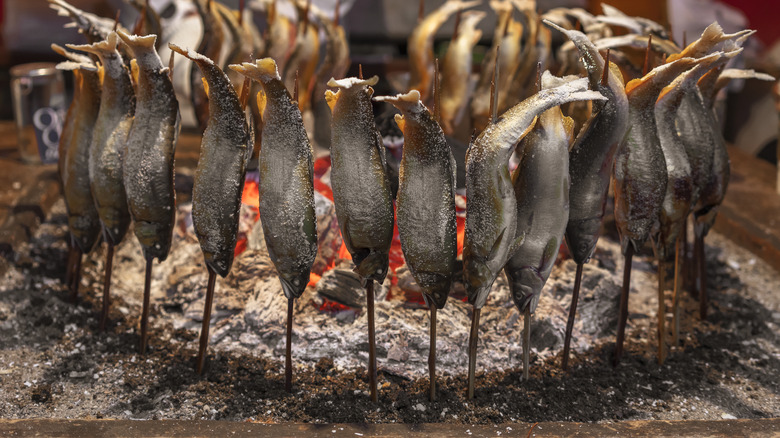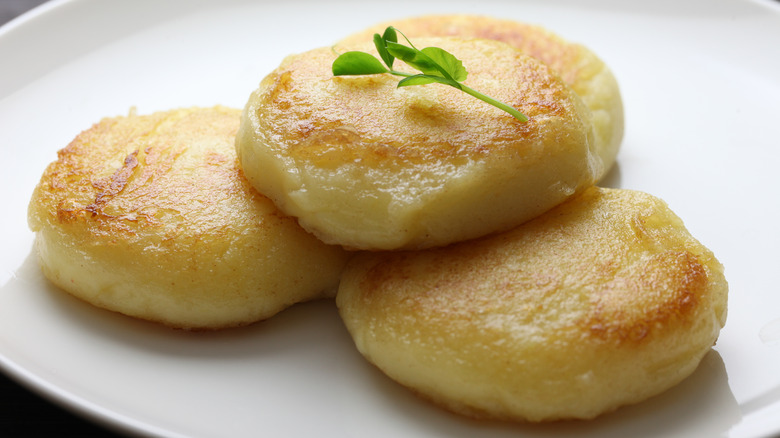12 Popular Dishes That Are Special To Hokkaido, Japan
At the far north of the Japanese archipelago, the island of Hokkaido stands out for a number of reasons. It's the largest of Japan's 47 prefectures, the northernmost, coldest, and least-densely populated, with just 5.4 million people on 22% of Japan's total land area, according to the Ministry of the Environment. But Hokkaido also contains a quarter of Japan's total farmland, more than any other region in Japan, thanks to major efforts in the 19th century to convert the island into an agricultural hub. Since then, Hokkaido has earned a reputation as Japan's "larder," the nation's major producer of rice, dairy, and other important agricultural products, in addition to top-notch seafood. Hokkaido is also one of the only parts of Japan inhabited and influenced by the indigenous Ainu people.
Given all these factors, it should come as no surprise that Hokkaido has developed a food culture like nowhere else in Japan. While Hokkaido meat, seafood, and vegetables have a reputation for quality, the island is also the birthplace of many Japanese dishes found nowhere else. Here are 13 of the most unique dishes of Hokkaido cuisine.
Jingisukan
In most of Japan, sheep are not commonly eaten, but in Hokkaido, sliced lamb or mutton is grilled tableside in a popular dish called jingisukan. The convex, dome-shaped grill used to cook the ingredients is what makes jingisukan unique. Meat is placed in the center of the dome, with vegetables like bean sprouts and sliced onion arranged around the edges. As the lamb cooks, the fat drips down the sides of the dome to flavor the vegetables. The meat is served unseasoned or marinated with a sauce made of sweet grated apple and onion that doubles as a dipping sauce.
The name jingisukan is a Japanese pronunciation of "Genghis Khan." There are various theories as to how this dish ended up being named after a Mongol emperor, some more credible than others, but the association of sheep meat with Mongolia and the resemblance of the domed grill to a Mongol warrior's helmet may both have played a role in the naming. According to Hokkaido-Magazine KAI, the first published recipe for jingisukan appeared in a 1931 manual on sheep husbandry, called "Wool Sheep and How to Raise Them," alongside 30 other sheep meat recipes. At the time, the Japanese government was actively encouraging Hokkaido farmers to raise sheep in an effort to build a domestic wool industry. Restaurants subsequently popularized jingisukan, becoming a beloved part of Hokkaido food culture, especially during the island's cold winters. However, the number of sheep raised in Japan has dropped steeply since the mid-20th century.
Hokkaido Milk
You might be surprised to learn that the fluffy, Western-influenced Japanese bread rolls known as "Hokkaido milk bread" outside Japan are not from Hokkaido at all. That name originated from advertising shokupan (bread rolls) made with Hokkaido milk, legendary in Japan for its quality and flavor. The secret to Hokkaido milk is Hokkaido itself: the island's cool weather, wide-open fields and fresh air provide an ideal environment for cows. Hokkaido milk is exceptionally rich and sweet, with a high-fat content and natural notes of vanilla.
In "Milk," food historian Mark Kurlansky describes how Japan's 19th-century government saw milk as the key to a strong and healthy population, leading to the establishment of Hokkaido's first dairy in 1876. According to SakuraCo, Hokkaido now produces more than half of Japan's milk, and Hokkaido milk is not only sold for drinking but used in a range of commercial products, including Bilk, a beer with 30% milk content. One of the most-popular treats made from Hokkaido milk is "soft cream" (soft-serve ice cream), sometimes flavored with other famous Hokkaido agricultural products like lavender or melon. Some Hokkaido dairies even let visitors churn and enjoy their own ice cream just hours after the cow was milked.
Yubari King Melon
Japan's limited agricultural land is used primarily for growing staples like rice and vegetables, so most fresh fruit available in the country is imported and relatively expensive. As a result, fresh fruit is regarded as a special treat, carefully curated and packaged to appear as beautiful as possible. Combined with the importance of gift-giving in Japanese culture, the unique status of fruit in Japan has led to the popularity of fresh fruit as a gift, which has, in turn, led to the development of high-end luxury fruits for gifting. One of the most exclusive of these is the Yubari king melon, a registered trademark of Yubari, Hokkaido, sometimes called the most expensive melon in the world.
A variety of cantaloupe, Yubari king melons are grown in volcanic soil in greenhouses and carefully tended by hand for over 100 days, a process which includes wrapping the melons in paper and polishing their rinds until they shine. After harvesting, they are classed into four grades according to appearance and sweetness, with only one in a thousand melons given the highest grade. Single melons can cost over $100 at specialty produce stores, but the most-perfect ones can reach astronomical prices at auction. In 2019, a pair of Yubari king melons sold for a record $45,000, according to the Japan Times, which is especially remarkable given that the melons are meant to be consumed within two or three days of harvesting.
Zangi
In Japanese, "karaage" is a general term for ingredients dredged in flour and starch and deep-fried, but in English, this word refers specifically to karaage fried chicken. Across Japan and beyond, chicken karaage is usually made from small pieces of sometimes un-marinated boneless chicken, especially the thighs. But karaage is not Japan's only style of fried chicken. In Hokkaido, you'll find a local style called zangi, which differs from karaage in a number of ways.
Unlike karaage, zangi is typically made with larger chicken pieces (sometimes bone-in), and the meat is marinated in ginger and soy sauce for additional flavor. The breading for zangi is also thicker than karaage; some recipes use a wet batter containing eggs, or dip the meat in egg before the flour and starch. Invented around 1960 at a restaurant called Torimatsu in the city of Kushiro, which is still in operation, zangi quickly spread across Hokkaido. Today, restaurants sell variations made with other proteins like octopus or fish, as well as a dish called zantare (zangi drizzled with sweet and sour sauce), which also originated in Kushiro a few decades after the original zangi.
Sapporo Ramen
Every part of Japan has its own regional styles of ramen, which can be grouped into three major subtypes, depending on whether the broth is flavored with salt (shio), soy sauce (shoyu), or salty fermented soybean paste (miso). Hokkaido is home to two of the three styles: both the oldest and the newest. In the city of Hakodate in southern Hokkaido, Chinese influence led to the introduction of light noodle soups flavored with salt, the original version of ramen. Heartier, more savory miso ramen, the youngest subtype, was developed in northern Hokkaido in the 1960s. Today variations of both are found throughout Hokkaido, including curry ramen, a cross between ramen and Hokkaido's popular curry soup (below).
Despite its relative youth, miso ramen has become the best-known and most popular Hokkaido style, especially a particular kind of miso ramen associated with Hokkaido's capital of Sapporo. Sapporo ramen features a fish or meat-based broth enhanced with red miso and thick, chewy noodles. The miso broth's bold flavors mean that Sapporo ramen is often served with heavier toppings than other ramen styles, like corn, cabbage, bean sprouts, and stir-fried ground pork. And like some other soups in Hokkaido cuisine, Sapporo ramen may be served with a pat of butter on top that melts into the ramen as you eat it.
Soup Curry
From its origins in India, curry (kari) reached Japan in a modified form through trade with Britain and was modified further into something uniquely Japanese. Today, Japanese curry is so popular that it has come to be regarded as one of Japan's national dishes. In most of Japan, curry is thickened with a flour roux and served alongside rice, but Hokkaido has a unique version, thanks to the island's love for warm soups in the wintertime. In Hokkaido, curry is made in the form of a soup simply known as supu-kari, soup curry, with rice served in a separate bowl. Fragrant with spices, soup curry often contains large pieces of meat and vegetables like okra, lotus root, corn, and potato.
A resemblance to the curry soups of South and Southeast Asia is no coincidence, as these dishes are believed to have inspired the invention of soup curry at a Sapporo restaurant called Ajanta in 1970s. Sapporo is still the center of soup curry in Hokkaido, and restaurants there now serve endless variations with customizable toppings and flavorings; you can even find soup curry made with Hokkaido lavender. Soup curry is not typically a breakfast dish, so Hokkaido residents were puzzled in 2020 when then-Prime Minister Yoshihide Suga claimed to have lost weight on a "morning soup curry diet," according to Japan Forward.
Ishikari Nabe
Nabe is a classic Japanese winter food, one of several styles of Japanese hotpot, spooned from a communal pot that bubbles at the table. This local nabe is named for the Ishikari River, Hokkaido's longest, and the fishing town of Ishikari at the river's mouth, known for its salmon since the Edo period (17th to 19th centuries). As you might guess, the key ingredient in Ishikari nabe is salmon, although other types of fish, like trout, may also be used. Pieces of salmon are added to a savory broth of miso and cooking wine, along with other ingredients like tofu and vegetables, especially corn and potato. Some recipes enhance the richness of the broth with butter or even milk.
The fishermen of Ishikari created the first Ishikari nabe by adding the bony offcuts of their catch to miso soup. This local delicacy first attracted national attention in the 1950s, during a period of increased tourism to Hokkaido from other parts of Japan. In Ishikari, tourists who came to witness Hokkaido's natural bounty and unique landscape and culture were permitted to help local fishermen pull in their seine nets bursting with salmon. As these tourists waited for their turn at the nets, they were served steaming bowls of Ishikari nabe, making the dish known to visitors from outside Hokkaido for the first time.
Ikameshi
If you get hungry during long-distance train travel in Japan, you can enjoy an ekiben: A special bento box lunch sold to travelers at train stations, with contents that vary depending on the location, as they showcase regional specialty foods. One of the best-known of these local ekiben delicacies is Hokkaido's ikameshi, originally served at Mori Station in the island's south. Literally meaning "squid rice," ikameshi is a whole squid stuffed with rice, cooked in a sweet/salty soy sauce braise and cut into slices for serving. A blend of regular and sticky rice is used to keep the filling from hardening when the ikameshi gets cold.
Ikameshi is said to have been first prepared around 1941 as part of rations for the Japanese army during World War II. The edible Japanese flying squid was being caught in large numbers at the time, while rice was being carefully rationed, so ikameshi made use of a common ingredient and allowed for the easy portioning of rice to individual soldiers. With travelers in the postwar era demanding rice in their train lunches despite food shortages, ikameshi became ideal as an ekiben food, which led to its fame spreading across Japan as Hokkaido tourism boomed in the 1950s and 60s.
Butadon
The region of Tokachi in southeastern Hokkaido has been a center for pig farming since the late 19th century. In the city of Obihiro in Tokachi, one of the most popular local specialties is butadon, a donburi (rice bowl) with pork slices. The meat is marinated in a sweet and salty sauce before being cooked, originally by grilling, although some restaurants now sell butadon made with crispy deep-fried pork.
Butadon's simplicity makes it a popular home-cooked meal, but there are many restaurants in Obihiro that specialize in the dish, including the famous Pancho, which claims to have been the first to serve it sometime in the 1930s. Pancho's founder Shuji Abe is said to have developed butadon to provide hardworking farmers and fishermen with a quick source of energy. Abe originally wanted to use eel in his rice bowls but settled on pork because it was the cheapest local protein, using the prepared sauce for Japanese grilled eel in the marinade. Abe's descendants still operate his restaurant today, which serves nothing but butadon in different sizes to customer's preference, with codenames like "pine" and "plum"; "flower," the extra-large size, features eight slices of pork.
Robatayaki
The Japanese suffix -yaki refers to grilling or pan-frying ingredients to order and is also found in the names of other cooking methods like teppanyaki, so you might translate robatayaki as "fireside grilling." It's a style of barbecue in which various ingredients, especially Hokkaido's famous seafood, are cooked over hot coals using a traditional sunken hearth called an irori, which resembles a stone-lined pit on the floor. Today, some robatayaki restaurants have the grill elevated on a dais instead.
Robatayaki, or robata for short, was originally prepared aboard the boats of Hokkaido fishermen, using wood charcoal enclosed in stone boxes. These fishermen later brought the custom of communal grilling into their homes, where the irori was the central family gathering place, also used for heating and brewing tea. When the first robata restaurant opened in 1950, this style of eating was already popular in Hokkaido homes and would remain so until gas, and electric stoves became widespread. At some robata restaurants today, servers still pass food to customers on a wooden paddle resembling a fisherman's oar.
Imo-mochi
Hokkaido's present-day reputation as an agricultural center only goes back about 130 years to the Meiji era, when the Japanese government made the establishment of agriculture in Hokkaido a top priority. Today, Hokkaido produces more rice than any other place in Japan. But before cold-resistant rice varieties were developed in the early 20th century, rice could not grow in most of Hokkaido at all. Potatoes, which grow well in cold climates, were recommended to Meiji-era farmers as an alternative staple. Native to the Americas, potatoes had been grown in Hokkaido since at least 1706 and may also have been cultivated by the island's indigenous Ainu, who acquired them from trade with Russia.
With potato's former role as a replacement for rice, it's no surprise that the people of Hokkaido developed a potato-based form of mochi, chewy rice cakes typically made from pounded glutinous (sticky) rice. Imo-mochi are potato croquettes made from mashed potato and potato starch. This mixture is shaped into round patties, which may be stuffed with cheese or other fillings before being pan-fried. Though residents of Hokkaido now have more access to rice than ever, imo-mochi remains popular and can be found throughout Japan as a bar snack or appetizer, sometimes seasoned with a mixture of butter and soy sauce.
Kujira-jiru
Long before agriculture transformed Hokkaido, the island's inhabitants subsisted mainly off the sea. The indigenous Ainu, who have called Hokkaido home since before the arrival of the Japanese, traditionally hunted whales and made use of every part of the animal in their cuisine, salting whale flesh and blubber (fat) for preservation and simmering it in soups. The Ainu custom of making whale soup was later passed down to Hokkaido's Japanese fishermen, who came to associate whales with good luck and the prosperity of a good catch. As a result, New Year festivities in Hokkaido fishing villages once included the eating of kujira-jiru, a soup made with salted whale blubber, tofu, vegetables, and a vegetable starch jelly called konjac. Blubber has a creamy, oily texture; its flavor can be fishy, but also has a nuttiness that some compare with a crispy fried egg.
Today, kujira-jiru is a rare delicacy, but it can still be found in some cities in Hokkaido during New Year and year-round at a restaurant in the southern port city of Hakodate. Popular media has helped to increase interest in the historical origins of Hokkaido's cuisine, like the acclaimed historical fiction manga series Golden Kamuy, which prominently features Ainu whale soup. As Hokkaido's rich food culture continues to evolve, the island's people preserve their traditional dishes while embracing new trends and innovations.
